5+ Terrific Tomato Trellis Ideas for Easy Harvesting
Check out these easy DIY tomato trellis ideas that include tomato stakes, cattle panels, pallets, wood, strings and more – sturdy enough for BIG plants.

I’ll share my tomato trellis system, as well as several other tomato trellis ideas from my homesteading friends. We have trellises that are wind resistant, tall, short, funky and budget friendly. I’m sure you’ll be able to one that works in your garden.
6 Reasons to Use a Tomato Trellis
Using a tomato trellis requires more effort than simply letting your tomatoes sprawl all over the place, but here’s why you should trellis your tomato plants:
- More tomatoes – Growing up instead of out allows you to grow more tomatoes in less space.
- No gymnastics required for picking – fruit is easy to access on your living tomato fence. I have not so fond memories of strange stretching and balancing in my mom’s garden in an attempt to reach ripe tomatoes in a vast expanse of tomato thicket.
- Less wasted fruit – Ask anyone who’s been gardening for a while, and I’m sure they’ve found overripe tomatoes hiding in the patch. With a tomato trellis, you can see your tomatoes to pick all your tomatoes.
- Less Disease – Tomato trellises provide better air circulation to plants, reducing diseases that thrive in damp, crowded conditions and soil-borne diseases.
- Cleaner tomatoes – No more mud and dust covered fruit.
- Less rodent and bug damage – I’m not saying that you’ll have no damage, but critters generally do less damage when fruit is harder to reach.
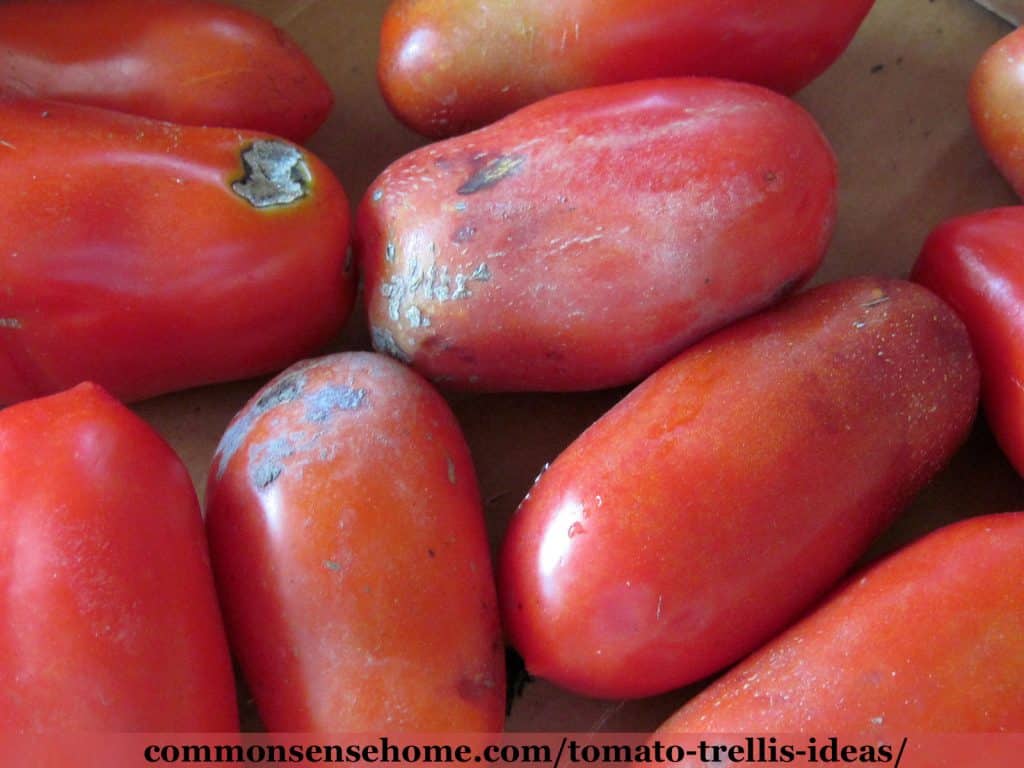
Trellises aren’t just for tomatoes, either.
Check out “Vertical Gardening – Grow More Food in Less Space” and “Grow Pole Beans on a Bean Trellis for Easier Picking and Preserving” for more garden ideas.
How tall should a tomato trellis be?
It depends on what types of tomato plants you are growing.
For determinant tomatoes (bush tomatoes), the small, round wire trellises you find at garden centers should get the job done.
Determinate tomatoes grow to a certain size, set fruit, ripen the fruit, and they’re done. They have a more compact, bushy habit, and stay fairly close to the ground.
For indeterminate tomatoes (which includes most heirloom tomatoes), a 5 to 6 foot (2 meter) tall trellis is better.
Indeterminate tomatoes keep growing and producing fruit until killed by frost. They provide a larger harvest, but also require a stronger trellis.
Will tomatoes grow up a trellis?
To keep your tomatoes headed up the trellis or cage, use small cloth strips or tomato clips. Tomato plants don’t have tendrils like cucumbers to hold on, so sometimes they need a little help.
If you’re using a string trellis, you can gently wind the plant around the string as it grows. With non-flexible trellis, you can also help the plant to wind around the supports as it grows, then secure with ties.
We usually use strips of old sweatpants or t-shirts, because they are soft and stretchy.

#1 – Wooden Stakes + Metal Posts Combination Tomato Trellis
This is the system we use in our garden.
Right after planting, pound in three 4′ tall wooden stakes near each tomato. One stake goes right next to the plant, the other two go about 10-12 inches on either side. The goal is a straight wall of stakes (and tomatoes).
When the plants are around a foot tall, pound in 6′ to 7′ tall steel fence posts at roughly 5 foot intervals along the row. Turn the posts perpendicular to the row to provide a wider surface to set the top cross piece on.
Attach a wooden cross piece to the top of the steel posts using cloth strips or wires. (Alternatively, The Planet Whizbang Idea Book for Gardeners includes a handy little bit of metal crafting that creates a Y-shaped top to your metal posts.)
As the tomatoes grow, tie the plants up with cloth strips or tether of your choice to the 4′ garden stakes. Prune as needed to create a “wall of tomatoes”
Once they reach the top of the 4′ posts, use cloth strips, string or twine from the top supports to continue to keep the plants going up. I use 7′ – 6′ steel posts, so this puts the tops of my tomatoes at 5′ to 6′. This is about all the higher I care to reach when gathering large quantities of fruit.
You can prune tops if needed to keep the tomatoes on the trellis, or train them sideways if you like. Most tomato varieties do not outgrow this tomato trellis system here in Wisconsin.
The video below shows off my hardwood stake + metal stake (post) trellis system. See if you can spot Miss Kitty. 🙂
Would you like to save this?
End of Season Storage
At the end of the season, I clip off the dead tomato plants, and wash the ties for reuse. (I untie the ties and put them in a zippered pillow case in the washing machine.) We stack the stakes and posts in the greenhouse to use again next year.
#2 and #3 – Cattle Panels and String Trellises
Teri at Homestead Honey uses cattle panels and string trellises for the tomatoes in their garden and greenhouse, plus several other trellis ideas in Garden Vertically with Trellises. The cattle panel tomato trellis is firmly braced at the bottom and positioned to form a tall arch.
A string trellis is dropped from above the plants and anchored in the ground below the plant. They can also be combined with a roller system to raise and lower plants as they grow, such as the RollerHook Tomato and Vine Crop Trellis.
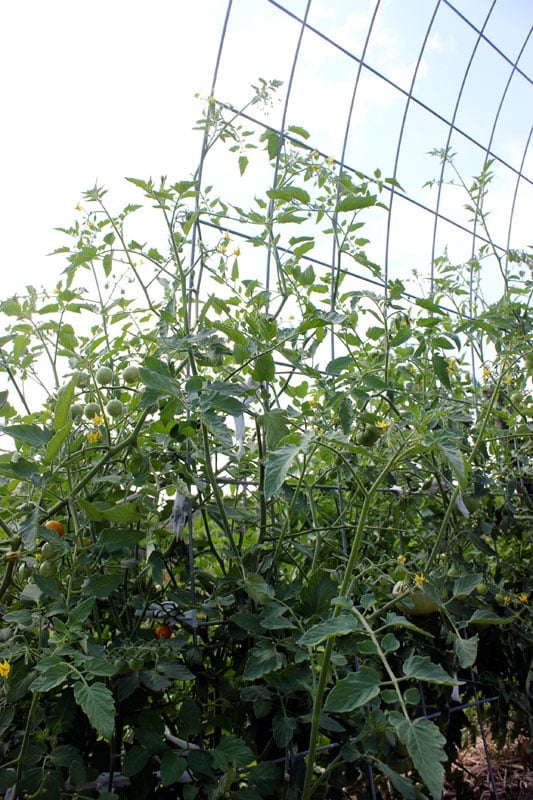
#4 – Recycled Pallet Tomato Trellis
Heather at Green Eggs & Goats turned cast offs from her husband’s work into colorful and creative trellises for her tomatoes and other garden crops in “Fun, Funky, Free Garden Trellis and Tomato Cage!“.
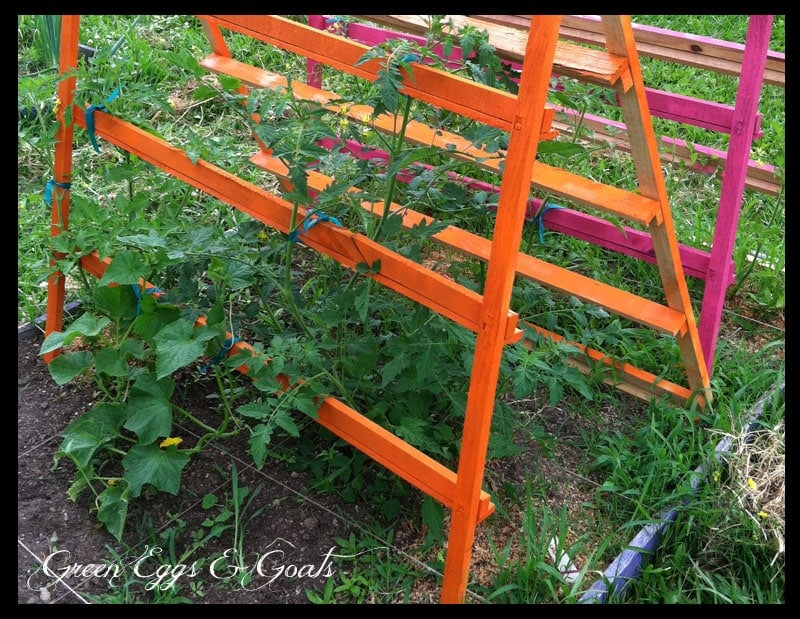
#5 – Beautiful Trellis Archway
Master Gardener Susan was lucky enough to have her husband build her this gorgeous decorative yet sturdy arched trellis. You can see the upright wooden sides of the trellis are anchored to the raised bed and supported by metal fence posts. She uses it for tomatoes and other vine crops.
You can learn more at “Building a Trellis for Tomato Plants“. I’ve seen similar arrangements made from PVC pipe.
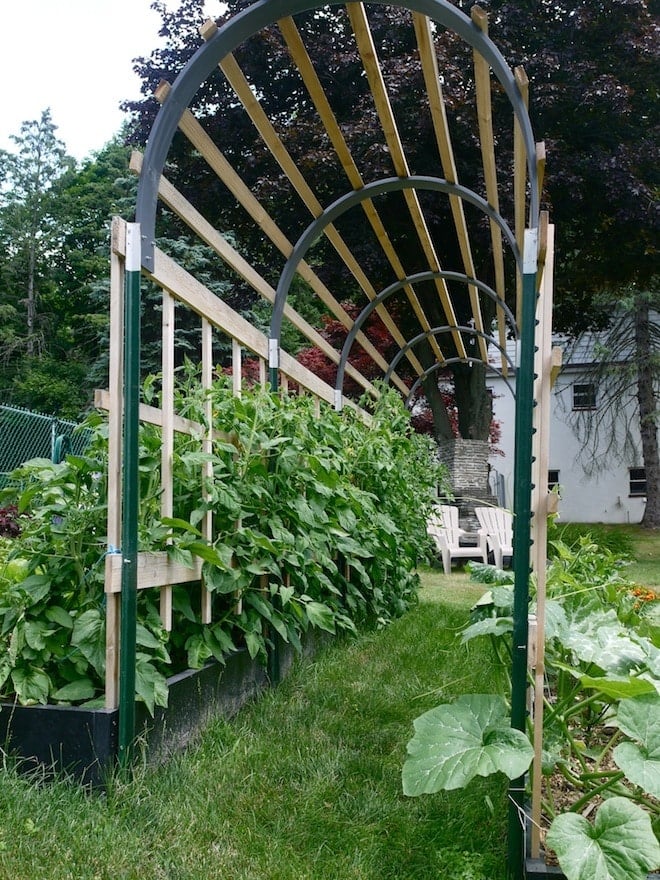
#6 – VineSpine™ Garden Trellis
Since I originally wrote this post, I received a set of VineSpine™ Trellises. Below you can see some young tomato plants with the panels placed in a zigzag arrangement.
Read more about these trellis panels in the post, “5 Reasons the Vine Spine is the Best Garden Trellis“.
I like using my VineSpine™ trellis panels in the greenhouses, since they are easy to move around.
Large Plant Cages for Tomatoes
You can also use the VineSpine™ Trellis panels to make a tomato plant cage for indeterminate varieties of tomatoes that are too tall for cages. (Well, too tall for regular tomato cages.)
I like trellises better than cages, but if you only have a few tomato plants, cages get the job done.
If you want more tomato growing tips check out:
- Grow Tomatoes from Seed – Save Money, Get More Varieties
- How to Grow Tomatoes Organically – Plus Innovative Gardening Techniques
- Tomato Flowers But No Fruit, or No Tomato Flowers – 9 Troubleshooting Tips
- 4 Reasons your Tomatoes Aren’t Ripening
- 7 Steps to Stop Blossom End Rot & Get Rid of Black Bottomed Tomatoes
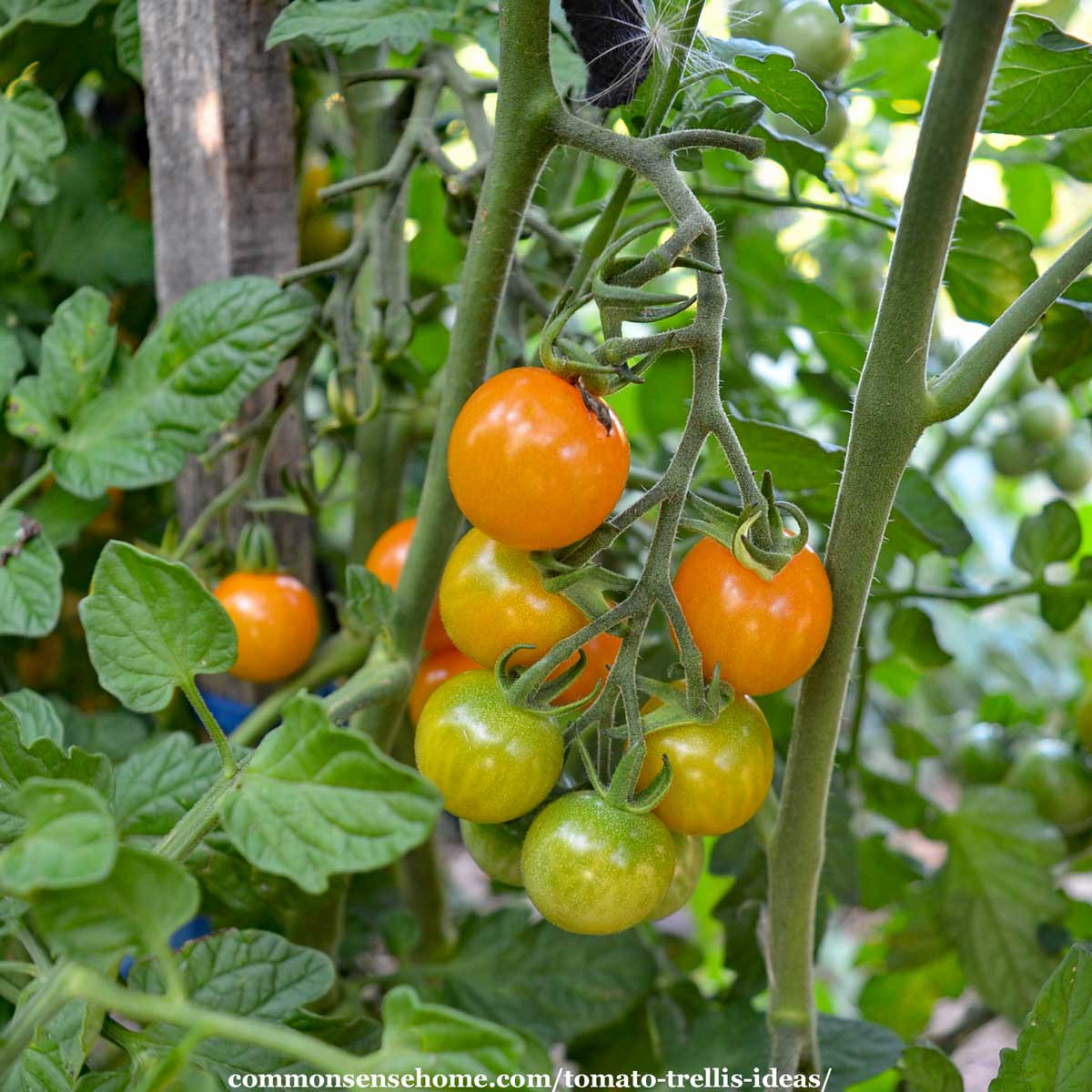
Originally published in 2014, last updated in 2020.


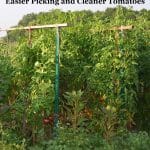
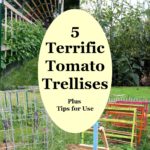
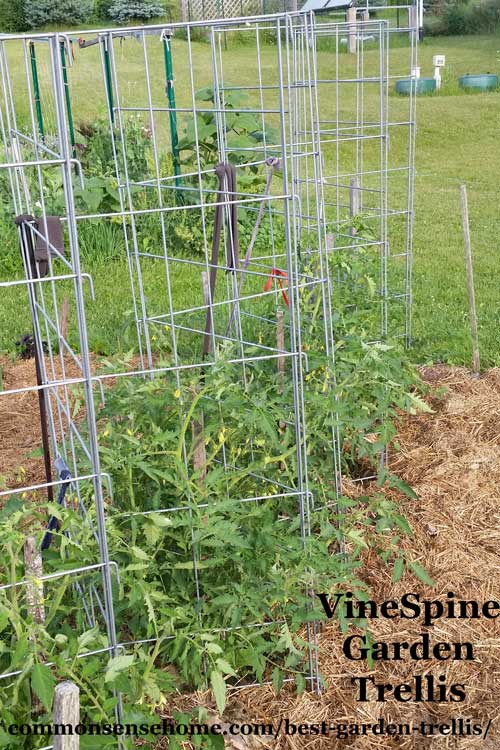

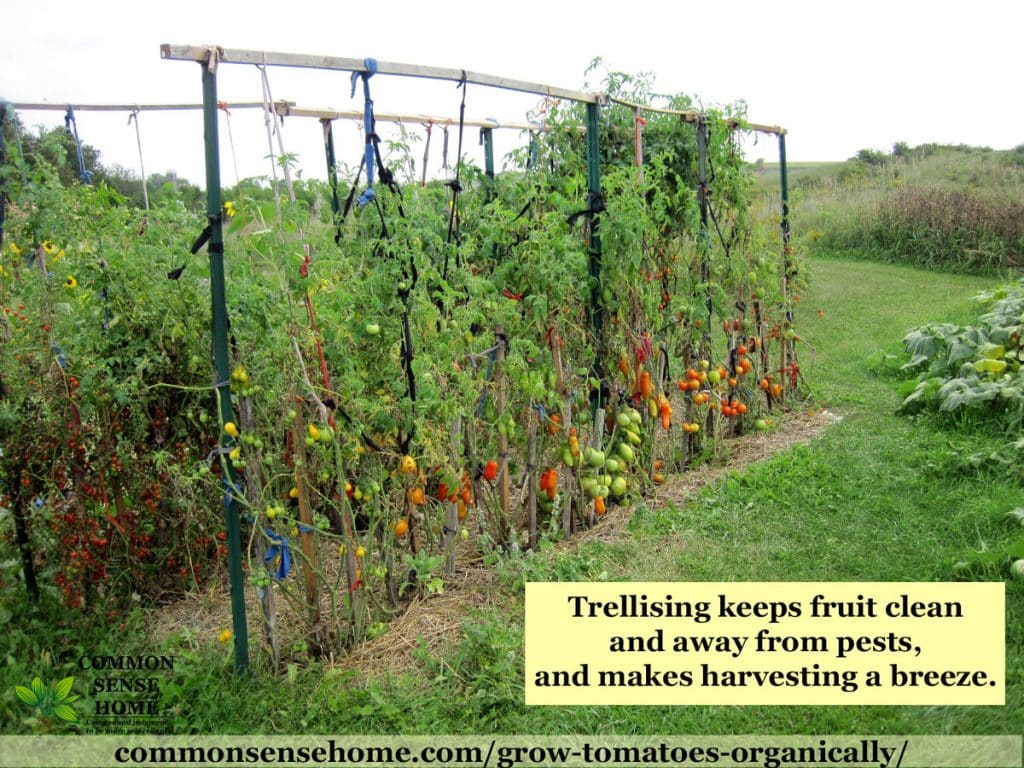
how far apart do you plant them within the row?
how far apart are your rows of tomatoes?
Thanks! Every year I tell myself I’ll give them more room because they seem so crowded at the end of the season; I just don’t want them to take up my whole garden.
If you plant indeterminate plants and don’t prune them, they will want to take up a large part of the garden. It’s the nature of the beast.
I aim for 2-3 feet between plants in a row, and at least 4 feet between rows. Anything much less than that without serious pruning and you will have a jungle.
If space is at a premium, you can clip them back to a single center vine to keep them from spreading, and use the string trellis method to keep them growing up. Many commercial growers do this in greenhouses to keep the plant footprints smaller. They coil the bottom of the stem at the base of the plant and lower the top as the foliage fades at the base.
I got tired of messing with tomato cages years ago, attempted the string method 1 year, didn’t care for that method. have been using catttle panels a few years and totally happy. wish i would have started with these 40 years ago. we just use zip ties to attach the panels to metal fence posts. I rotate my tomatos every year so it’s very easy to break down and move, they are super sturdy. i plant on both sides alternatally. I weave the plants in the wire so I don’t have to use any ties.
The strings only method doesn’t work so well in our main garden because we get so much wind. Glad you have had good luck with cattle panel trellises.
I love the cattle panels, I just use twine to tie the plants to them, put in steel fence post to hold them up and you can reuse them for a very long time. I actually have them welded on a frame horizontally and use a post on each end. They cost about $22.00 new but you will only buy them once.
And I know you’ve had yours for many years.
I use the cattle panels – both horizontal & arched. My arched ones I have driven 1 or 2 T-post in the ground and then about 3.5 or 4 feet away drive the other one or two. Put one side against the inside of T-post, then get on the other end of cattle panel and walk it towards the other side and slide it in place so that the T-posts are on the outside of the arch. I am almost 60 and fix these by myself. Two T-post are much more stable than 1 but last year I grew so many tomatoes that I was short on T-post so resorted to 1 on each side.
Tie a string or rope to the end you want to bend then anchor the other end.
You have to anchor one side or end of the wire panel with a board(2 X 6) or post (4 x 4).
Pull the rope down to the post on the other side of the bed & nail the wire to the other post.
http://forums.gardenweb.com/discussions/2195762/built-my-first-cattle-panel-arch-trellis-today
How does anybody bend the cattle panels I can’t do it by myself
I think people bend them over things and let their weight do the work, or are just brawny. I find the panels unwieldy. The VineSpine trellis offers similar support, but the panels are cut and ready to link in different layouts with much less work. I had zigzags for my tomatoes, and used a couple single panels against a post for cucumbers.
Those flimsy tomato cages are supposed to be used in determinate tomatoes, not for the indeterminate which require the trellises, stakes, etc.
Even my determinate tomatoes overwhelmed the commercial cages. I guess I fed them too well…
I’m using a piece of old rep that was left over from concreting. Works well for romas.
used hog wire (48 inch wire with 4 X 4 inch square holes) looks like concrete wire in circle about 24 inches.
I used wild bamboo, once I cut 8-10 foot poles & buried 18 inches deep, so I could use them with pole beans the next year. I planted the seeds & transplanted the salad tomato plant in the nest of 10 foot bamboo poles. The plants got 6-8 inches tall, bushed out & bloomed. I checked the seed catalog & I had bought bush patio tomato seeds. I Had to laugh at the small 8 inch plants in a circle of 8 foot poles.
Some of us learn by doing. I am going to try garden mats this year, let you know what I found out.
garden mat.com
I hope you still got some tomatoes, even if they didn’t need the big supports.
Love these ideas. I built a trellis last year but it didn’t hold up all that well. The cross beam on top looks like it’ll fix that! Thank you 🙂
The best idea I’ve seen for tomatoes is a wire cage made from concrete reinforcement wire.
The openings are 6 by 6 so it easy to access and pick tomatoes. The cages can be used for,
cucs or any other vining plant. Although they rust they will last for many years. Simple to
make, very sturdy and 5 ft high. Don’t know how to send pics to you. H
I’m familiar with that type of cage, thank you. They are sturdier than store tomato cages, for sure.
I love the idea of the frame and cloth ties and I have a perfect place to do this. I have a 8′ raised bed with a “post & beam” frame up on the long side already: my question to you is, what kind of spacing do you allow for this type of set up? If I prune them to grow straight up, do I keep them 2 feet apart or closer?
Even when training up as much as possible, with heirloom plants I allow at least 3 feet between plants because they will spread if allowed to do so. You might be able to place them closer if you do more pruning and training.
Love archways! I have to build one in the new garden. Too bad I don’t know where the archway can go yet, as I haven’t seen the garden without snow and with leaves on the trees yet. I think I’ll combine cucumbers and beans on it though.
That should do a good job confusing the cucumber beetles. 🙂
Lol “What do I eat first? Can’t decide!” 😉
We didn’t have any last year, or I didn’t see them. Then again the beans were on their own, up the shed wall. I do plant lots of Marigold and Nasturtium everywhere too. They are quite beautiful and are good companions for many plants.
I just hope I’ll have enough time between moving and the day job and unpacking and getting beds up to actually grow anything 🙂
Fantastic ideas! I would love to do one of these next year in my garden. I don’t have the space like you do, but I could probably do a mini version of one of these. Thanks for sharing!!
Thanks for the great tomato trellis ideas, and for including my cattle panel trellis. We are using the same system this year in two ways – one in an arch, as featured in the photo, and one bed using the cattle panel horizontally . I’m not sure exactly how I’ll tie up the tomatoes, but I think they will both be great systems!
Happy growing!
I’d be curious to see what you work out.